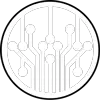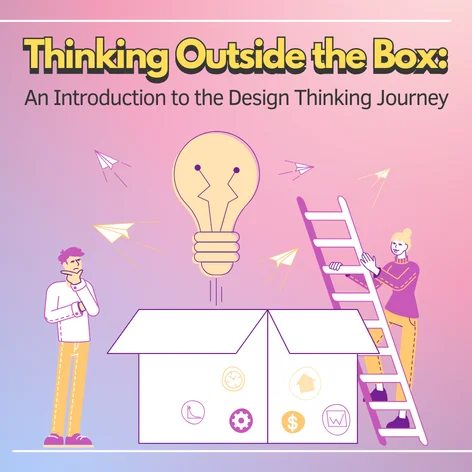This blog post looks over how design thinking and process can save you time and energy. It also provides a space for the best ideas and solutions to come up. We’ll explore design thinking, explain the 5 stages of the design thinking process, and learn how to use it.
As a designer, employee, business team member, or simply as a human being, you’ve likely faced moments requiring creative ideas, whether for your job, projects, or personal challenges. Like everyone else, you’ve experienced both the satisfaction of solving problems with brilliant ideas and the frustration of not finding a solution despite your efforts.
Yet, clichéd as it may sound, there’s always a solution!
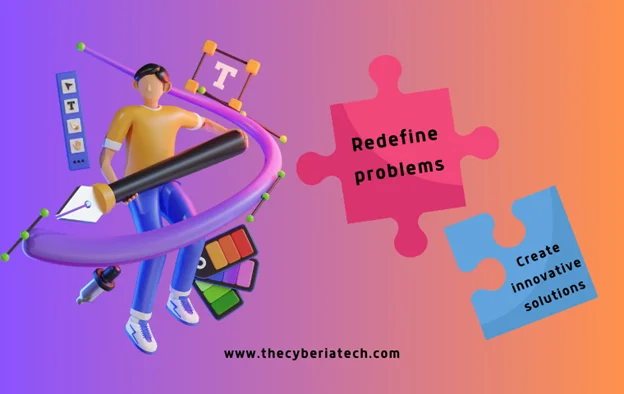
what is design thinking?
Herbert A. Simon, a Nobel Prize laureate, was the first person to mention Design thinking in 1969. Design thinking is a method that focuses on finding creative solutions to problems. it’s a non-linear and iterative process that involves understanding users deeply and caring about their needs and feelings.
For a deeper understanding of design-thinking methodology, take a look at this short video.
Why Is Design Thinking so Important?
This method allows teams to break free from traditional thinking patterns and unlock their creativity to develop the best solutions. This approach is not just for designers; everyone on a team can use it.
let’s begin with an example. Please, take a moment to look at your mobile phone. This invention was created to address a specific issue.
We discovered a problem with connection and communication, and we were able to find a practical and relevant solution.
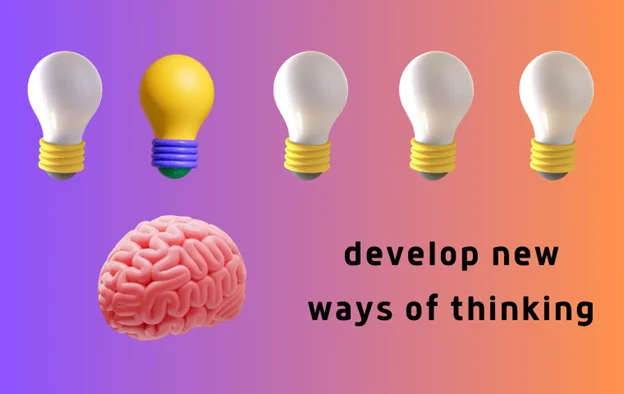
the Five Stages of Design Thinking
Hasso Plattner at Stanford University’s Institute of Design originally developed the design thinking process, which usually consists of five stages. However, in real-world applications, it’s not always a straight line. You might go through some phases multiple times and move back and forth between them.
As you progress through the steps, you’ll notice that they can sometimes overlap or require repetition. keep in mind that it’s a flexible and dynamic process that allows you to explore and revisit stages if needed. Now let’s see principles of design thinking:
Empathize: Analyze What Its Customers Want
The initial stage of the design thinking method involves empathy. This phase is carried out in order to gain a better understanding of the actual needs of the users. During this phase, you fully engage with the users’ environment to better understand their problems and how they approach solving them.
It can be challenging but extremely important to grasp the specific difficulties and frustrations that the individuals we are designing for may experience in UX design. I suggest that you begin your design thinking journey by understanding and empathizing with your users. This article provides a comprehensive overview of various methods and processes.
Define: Explain the Issues and Needs Your Users Have
In order to fully comprehend a problem, it is necessary to clearly define it. It’s not easy. To find the right solution, it’s important to first clearly understand and define the problem.
This involves taking a human-centred approach, where you develop, refine, and reframe the problem until you have a solid understanding of what the actual and practical solution should be.
During this stage, we carefully observe and combine the data that was collected and emphasized earlier. In this stage of design thinking, designers should avoid approaching problem-solving based solely on their personal preferences or desires.
To effectively address the issue, it is important to consider the problem from the viewpoint of the target audience. How does defining a problem assist in the process of finding solutions that are both desirable and usable? It seems like you have a question.
Ideate: Question Preconceptions Think Outside the Box and Generate New Ideas
During this stage, your goal is to generate as many potential solutions as possible. During the ideate stage in design thinking, designers explore creative and unconventional approaches to find different ways and solutions.
Some ideas may appear feasible, while others may be dismissed. In this context, designers prioritize quantity. In this phase, designers focus on generating solutions that are both relevant and innovative.
There are several techniques for generating ideas, such as brainstorming, brainwriting, worst possible ideas, and storyboarding.
There are numerous techniques available, but we will mention just a few here. This phase is crucial because it can result in a design that is both relevant and innovative.
Prototype: Begin by coming up with some creative responses
In the design thinking process, one of the steps is creating a prototype, which is a mock-up version of the product. This prototype is then tested to gather feedback and make improvements.
We are currently in an experimental phase where we are exploring different solutions to find the best one. During the ideate phase, the solutions that are proposed can either be accepted, improved upon, or rejected.
Finally, the designers will gain a better understanding of how users might feel, think, or behave when they interact with their design.
Test: Take your ideas and put them to the test
The final step in the design thinking method is to test the complete product using the best solutions that were identified during the prototype phase.
The results from this phase will help designers better understand the needs and preferences of users. Occasionally, the outcomes can circle back to earlier phases.
The results from this phase demonstrate how accurately the designers have executed their designs.
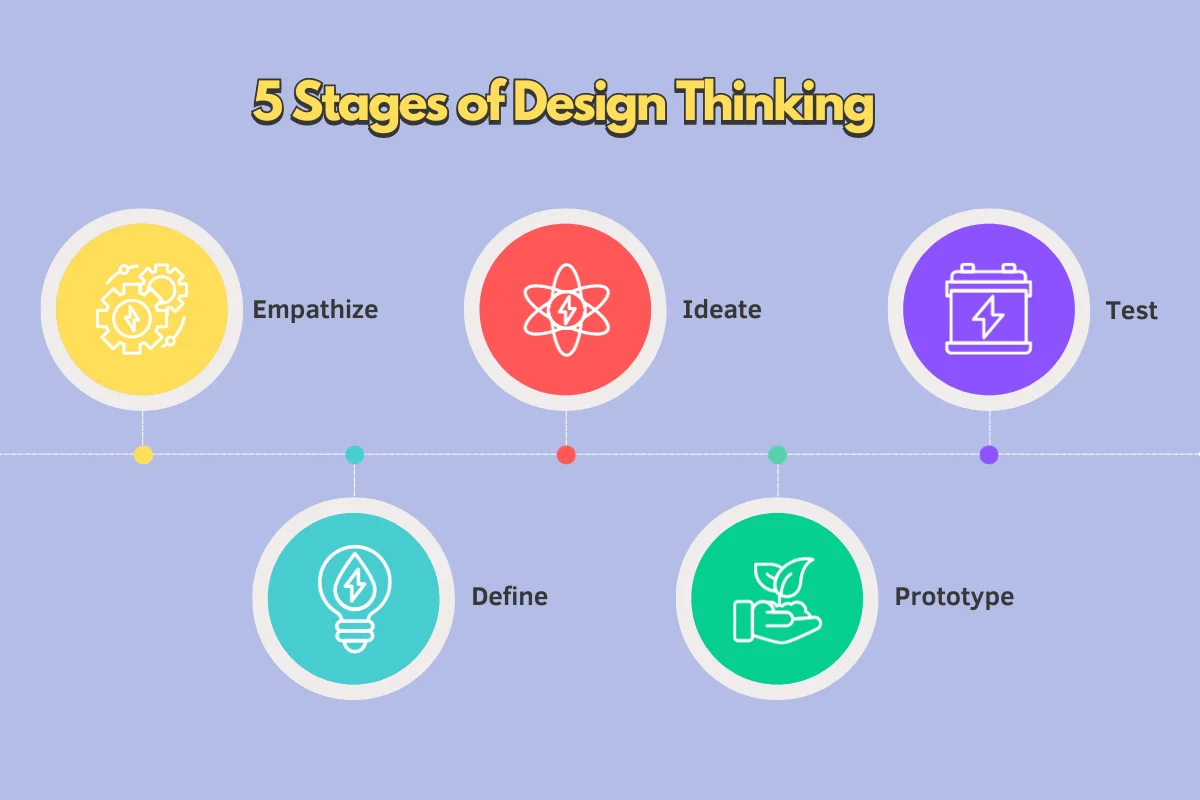
benefits of design thinking
Design thinking can help you in many ways. Here are some of the benefits of design thinking to consider when choosing your method to approach problems.
Better Communication
The collaborative nature of design thinking improves communication within teams and the end users, ensuring the ideas are effective.
increased empathy
Design thinking is about understanding the feelings of others, leading to more empathetic solutions.
lowered risk of drawbacks
Through testing and prototyping, design thinking minimizes the risk of potential issues or drawbacks in the final solution.
better alignment with your goal
Design thinking ensures that the solutions developed align closely with the intended goals, enhancing overall effectiveness.
outside the box thinking
Design thinking is a problem-solving approach that encourages people to think creatively and explore unconventional ideas. It can be a valuable tool for fostering innovative and out-of-the-box thinking. The individuals who utilize this methodology are:
being more flexible
Design thinking is adaptable, allowing teams to adjust their approach based on feedback and evolving circumstances. leading to more open-minded and effective decision-makingprocesses.
better identification of the problem
Design thinking eases problem identification through “empathies” and “test” stages, ensuring that the root causes are addressed rather than just the symptoms.
The Power of Stupid Questions
In design thinking, it’s essential to recognize the value of asking seemingly simple or “stupid” questions.
These questions may appear simple or obvious initially, but they can provide valuable insights and foster creative solutions. When it comes to UI/UX design, asking questions that may seem simple or obvious can be quite beneficial. This allows team members to freely express their perspectives and ideas without worrying about being judged.
The power of asking seemingly silly questions is that they can challenge our usual way of thinking and open up new opportunities. This can result in finding better design solutions that genuinely address the users’ needs.
Design Thinking Examples
Netflix, Tesla, and more are among the best-known brands and markets in the world that have been shaped by design thinking.
The video below showcases how Netflix embraced design thinking, transforming from a DVD rental service to an online streaming giant. It highlights key aspects such as customer-centric evolution, user-friendly UX/UI design and the use of beta testing for continuous improvement.
Also, you can watch this case study on how Tesla used design thinking to become one of the top automakers in the world, Addressing the global warming challenge, tesla focused on sustainable transport. Through iterative testing, prototyping, and adding features like autopilot, adult mode and more they continuously improved their electric cars.
3 Online Design Thinking Tools
Here are three of the best online design thinking tools to help you and your team work better with each other and come up with the best ideas:
- Miro: Miro is a digital whiteboard for design-thinking teamwork. Whether you’re starting from scratch or using a template, Miro lets your team easily share ideas with sticky notes, mind maps, and even freehand drawings. It speaks over 100 languages, breaking down communication barriers. With this tool, collaborative problem-solving becomes easier.
- Figjam: FigJam serves as a collaboration tool for you and your team to brainstorm, develop, and organise ideas. No prior design tool knowledge is necessary to start exploring and creating, allowing everyone to join in and contribute.
- Clickup: ClickUp helps you handle the whole design process in one easy-to-use space. Create problem statements and project plans with templates, or jump into Whiteboard View to brainstorm solutions.
Design Thinking in User Experience Design
Design thinking, as a UX methodology, involves examining the problem at hand and suggesting solutions while taking into account the steps that have been mentioned. Designers can utilize design thinking as an approach or mindset to enhance the user experience while optimizing UX design.
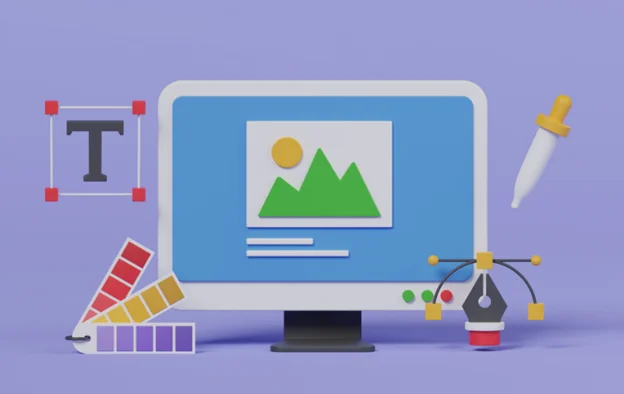
In their job, UX designers utilize various frameworks. When using the design thinking method, people go through a series of steps: they start by empathizing with the users, then define the problem, come up with ideas, create prototypes, and finally test their design. When designing a product, they place their focus on three key aspects:
• Desirability
• Viability
• Feasibility
Can you explain what Desirability, Viability, and Feasibility mean in the context of design? A product that includes these three features can bring added value to businesses while also reducing bugs and risks.
frequently asked questions
Teams employ design thinking, an iterative process that involves understanding users, challenging assumptions, redefining challenges, and designing and prototyping novel solutions.
Designers, like painters, try to come up with novel approaches to problem-solving, hence their manner of thinking is sometimes compared to “thinking outside the box.”
Design thinking comes in handy for solving problems in all aspects of life, whether it’s in education, business, or healthcare.
Let’s sum it up
To sum it up, design thinking is like a problem-solving tool, making things easier and more fun while bringing out the best ideas. It’s not just for design experts; it’s for anyone who needs better ideas for their life, job, or any situation.
With mentioned stages of design thinking, you can explore and go back and forth as you need until you find the best solutions. So, hop on the design thinking train for a more creative and exciting way to tackle problems!

